I built my first boat when I
was 14. Actually my dad did most of the building while my brothers
and I watched. We did help a little. I was always amazed with
what my dad could do with a stack of wood, or a hunk of metal.
So, I wasn’t the least bit surprised when my own teenagers
looked at me with doubt when I picked out a couple of sheets of
plywood and told them I was going to make a kayak to paddle in
our local waves. That was a few years and a few boats ago. And
just like with my dad and me they don’t have doubts any
more.
A waveski is purely a surfing craft
that you paddle like a kayak, except you sit on top of it instead
of inside it. Once you take off on a wave it surfs much like a
surfboard. The waveski design is very popular in other oceans
of the world, but it is still fairly unique here in the United
States.

The WoodySki is my own design based
partly on other surf design kayaks that I have built. I start
by sketching ideas and then turn to CAD and other software to
develop the design. I print out small-scale patterns on heavy
paper, and then use this to make models of several prototypes.
After coating these with plastic I can do more assessments and
refinements by floating these in water and adding scaled body
weight.
My girls and I had some good times
building this latest project and they can’t wait to give
it a go this summer, when the Oregon coast weather and waves get
a bit milder. I’m already having a ball on it.
The shell of the WoodySki is made from 6 parts
that are cut from 2 sheets of 1/8” plywood.
Three permanent bulkheads help make the alignment
foolproof.
The hull is filled with foam in the areas
of the seat and foot wells, and where extra rigidity is desired.
A durable skin of epoxy, and fiberglass are
bound to the exterior creating a strong, lightweight composite.
This WoodySki is designed for a paddler weight
between 150 and 200 pounds.
The finished length is 7’ 9”.
The standard final weight is 20 Lbs.
Design Details
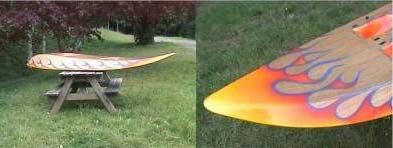
- The WoodySki design is based on a combination of surf craft
including the Woody 2.8 surf kayak. It is designed for high
performance surfing as well as stability and ease of paddling.
- The final design was developed using a combination of: Computer
software programs, modeling, and physical testing, along with
the input of other experience paddle surfers.
- The bottom of the WoodySki is based on a 3 surface planning
design, with side lift tapering to a completely flat surface
at the stern.
- Hard-edged rails are combined with the bottom feature for
sure carving ability.
- The nose outline is factored in with bow rocker for steep
drops and tight turns.
- The WoodySki is designed for an O’Fish’L snap
in fin system which allows a surfer to add or remove fins while
on the water; no tools required.
Construction Details
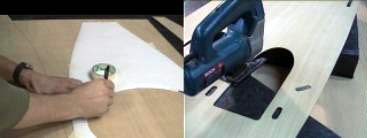
All of the body parts are traced from full size patterns and
then cut from 2 sheets of pseudo-mahogany plywood.
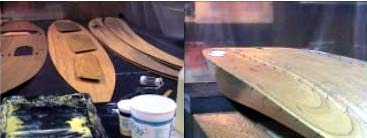
The parts are stitched together every few inches with thin wire.
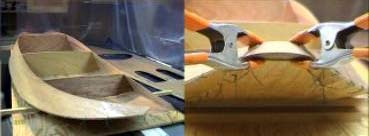
The interior bulkheads, tail panel, and nose piece help to align
and strengthen the craft.
All protruding wire ties are cut and made flush.
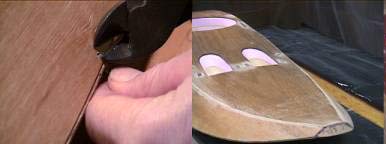
The interior seams are glued, the deck is connected and the interior
of the waveski gets some foam.
Foam is used to form the seat and foot wells while also adding
strength and safety.
The body is inspected, sanded, and detailed with thickened epoxy.
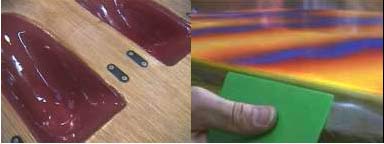
The bottom gets paint, graphics and a layer of S-glass.
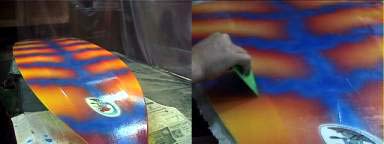
After a light sanding the bottom gets a gloss coat of epoxy.
The finbox covers are removed, which completes the bottom.
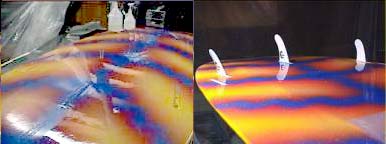
The topside gets similar treatment with; paint, glass, and gloss.

The WoodySki is finished with foot straps, seat belt, and optional
thigh straps for that familiar kayak feel.

WoodySki
3min video, 4MB
The above link will open a sample clip of the full instructional
video, which includes some WoodySki surfing.
Full size patterns, builders guide, and 75 min. instructional
video will take you through the entire project for $79.95 Shipping
is free anywhere in the continental United States and British
Columbia.
For more details contact the author David Church at: dchurch@harborside.com

|

